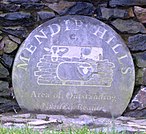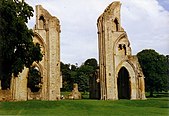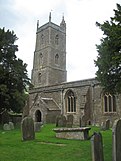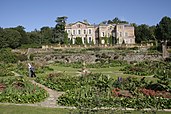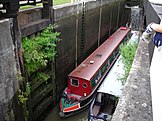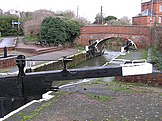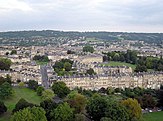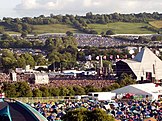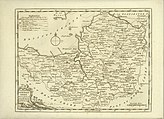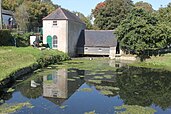Portal:Somerset/Selected article
Selected article 1
Portal:Somerset/Selected article/1

The hills run from the Vale of Taunton Deane in the south, for about 15 miles (24 km) to the north-west, ending at East Quantoxhead and West Quantoxhead on the coast of the Bristol Channel. They form the western border of Sedgemoor and the Somerset Levels. Soil types and weather combine to support the hills' plants and animals. In 1970 an area of 6,194.5 acres (2,506.9 hectares) was designated as a Biological Site of Special Scientific Interest.
They have been occupied since prehistoric times with Bronze Age round barrows and Iron Age hill forts. Evidence from Roman times includes silver coins discovered in West Bagborough. In the later Saxon period, King Alfred led the resistance to Viking invasion, and Watchet was plundered by Danes in 987 and 997. The hills were fought over during the English Civil War and Monmouth rebellion but are now a peaceful area popular with tourists and walkers. (Full article...)
Selected article 2
Portal:Somerset/Selected article/2
The Grand Western Canal ran between Tiverton in Devon and Taunton in Somerset. The canal had its origins in various plans, going back to 1796, to link the English Channel and the Bristol Channel by a canal, bypassing Lands End. An additional purpose of the canal was the supply of limestone and coal to lime kilns along with the removal of the resulting quicklime, which was used as a fertiliser and for building houses. This intended canal-link was never completed as planned, as the coming of the railways removed the need for its existence.Construction was in two phases. A level section from Tiverton to Lowdwells on the Devon/Somerset border, opened in 1814, and was capable of carrying broad-beam barges, carrying up to 40 tons. The Somerset section, suitable for tub-boats, which were about 20 feet (6.1 m) long and capable of carrying eight tons, opened in 1839. It included an inclined plane and seven boat lifts, the earliest lifts to see commercial service in the UK. The lifts predated the Anderton Boat Lift by nearly 40 years.
The Devon section remains open, despite various threats to its future, and is now a designated country park, and allows some limited navigation. The Somerset section was closed in 1867, and is gradually disappearing from the landscape, although sections are now used as a footpath. It maintains a historical interest and has been subject to some archaeological excavations. (Full article...)
Selected article 3
Portal:Somerset/Selected article/3
Exmoor National Park is a national park situated on the Bristol Channel coast of South West England. 71% of the National Park is located within the county of Somerset and the remaining 29% is in Devon. The park, which includes the Brendon Hills and the Vale of Porlock, covers 267 square miles (692 km2) of hilly open moorland and 34 miles (55 km) of coast. It is primarily an upland area with a dispersed population living mainly in small villages and hamlets. The three largest settlements are Lynton and Lynmouth, Porlock and Dulverton, which together contain almost 40% of the National Park population.Prior to being a park, Exmoor was a Royal Forest and hunting ground, which was sold off in 1818. Exmoor was one of the first British National Parks, designated in 1954, under the 1949 National Parks and Access to the Countryside Act, and is named after its main river, the River Exe. Several areas of the moor, including the Coastal Heaths, North Exmoor, South Exmoor and Chains, have been declared a Site of Special Scientific interest due to the flora and fauna. In 1993 Exmoor was designated as an Environmentally Sensitive Area. (Full article...)
Selected article 4
Portal:Somerset/Selected article/4
Chew Valley Lake is a large reservoir in the Chew Valley, Somerset, England, and the fifth-largest artificial lake in the United Kingdom (the largest in south-west England), with an area of 1,200 acres (4.9 km2). The lake, created in the early 1950s and opened by Queen Elizabeth II in 1956, provides much of the drinking water for the city of Bristol and surrounding area, taking its supply from the Mendip Hills. Some of the water from the lake is used to maintain the flow in the River Chew.Before the lake was created, archaeological investigations were carried out that showed evidence of occupation since Neolithic times and included Roman artefacts. The lake is an important site for wildlife and has been dedicated as a Site of Special Scientific Interest (SSSI) and a Special Protection Area (SPA). It is a national centre for birdwatching, with over 260 species recorded, including some unusual sightings. The lake has indigenous and migrant water birds throughout the year, and two nature trails have been created. The flora (plants) and fauna provide a variety of habitats and include some less common plants and insects.
Some restricted use for recreational activities is permitted by the owner, Bristol Water, including dinghy sailing and fishing, primarily for trout. (Full article...)
Selected article 5
Portal:Somerset/Selected article/5
The Mendip Hills (commonly called The Mendips) are a range of limestone hills situated to the south of Bristol and Bath in Somerset, England, United Kingdom. Running east to west between Weston-super-Mare and Frome, the hills overlook the Somerset Levels to the south and the Avon valley to the north. The hills give their name to the local government district of Mendip, which covers most of the area.The hills are largely carboniferous limestone, which is quarried at several sites. The higher western part of the Hills have been designated as an Area of Outstanding Natural Beauty (AONB), with an area of 200 km2 (80 sq mi), which gives it the same level of protection as a national park. The Mendip Hills AONB Service and Somerset County Council's outdoor education centre is at the Charterhouse Centre near Blagdon.
The Mendips are home to a wide range of outdoor sports and leisure activities, many based on the particular geology of the area. It is recognised as a national centre for caving and cave diving. In addition to climbing and abseiling, the area is popular with hillwalkers and those interested in natural history. (Full article...)
Selected article 6
Portal:Somerset/Selected article/6

The landscape consists of the valley of the River Chew and is generally low-lying and undulating. It is bounded by higher ground ranging from Dundry Down to the north, the Lulsgate Plateau to the west, the Mendip Hills to the south and the Hinton Blewett, Marksbury and Newton St Loe plateau areas to the east. The River Chew was dammed in the 1950s to create Chew Valley Lake, which provides drinking water for the nearby city of Bristol and surrounding areas. The lake is a prominent landscape feature of the valley, a focus for recreation, and is internationally recognised for its nature conservation interest, because of the bird species, plants and insects.
The area falls into the domains of councils including: Bath and North East Somerset, North Somerset and Mendip. Part of the area falls within the Mendip Hills AONB. Most of the undeveloped area is within the Bristol/Bath Green Belt. Many of the villages date back to the time of the Domesday Book and there is evidence of human occupation since the Stone Age. The main village is Chew Magna but the largest are Pensford, Clutton, Bishop Sutton, High Littleton and Temple Cloud (Full article...)
Selected article 7
Portal:Somerset/Selected article/7

The Parrett's main tributaries include the Rivers Tone, Isle, and Yeo, and the River Cary via the King's Sedgemoor Drain. The 37-mile (60 km) long river is tidal for 27 miles (43 km) up to Oath. Because the fall of the river between Langport and Bridgwater is only 1 foot per mile (0.2 m/km), it is prone to frequent flooding in winter and during high tides. Many approaches have been tried since the early 19th century to reduce the incidence and effect of floods and to drain the surrounding fields.
During the Roman era the river was crossed by a ford, and in Anglo-Saxon times formed a boundary between Wessex and Dumnonia. From the medieval period the river served the Port of Bridgwater, enabling cargoes to be transported inland. The arrival of the railways led to a decline and commercial shipping now only docks at Dunball. Man's influence on the river has left a legacy of bridges and industrial artefacts. The Parrett along with its connected waterways and network of drains supports an ecosystem that includes several rare species of flora and fauna. The River Parrett Trail has been established along the banks of the river. (Full article...)
Selected article 8
Portal:Somerset/Selected article/8
The Sweet Track is an ancient causeway in the Somerset Levels. It was built in 3807 or 3806 BC and has been claimed to be the oldest road in the world. It was the oldest timber trackway discovered in Northern Europe until the 2009 discovery of a 6,000 year-old trackway in Belmarsh Prison. It is now known that the Sweet Track was largely built over the course of an earlier structure, the Post Track.The track extended across the marsh between what was then an island at Westhay, although much of the marsh has now been drained, and a ridge of high ground at Shapwick, a distance close to 2,000 metres (6,600 ft). The track is one of a network that once crossed the Somerset Levels. Various artefacts, including a jadeitite axe head, have been found along its length.
Construction was of crossed wooden poles which were driven into the waterlogged soil to support a walkway that consisted mainly of planks of oak, laid end-to-end. The track was only used for a period of around 10 years and then abandoned, probably due to rising water levels. Following its discovery in 1970 most of the track has been left in its original location, with active conservation measures taken, including a water pumping and distribution system to maintain the wood in its damp condition. Some of the track is stored at the British Museum and a reconstruction of a section was built at the Peat Moors Centre near Glastonbury. (Full article...)
Selected article 9
Portal:Somerset/Selected article/9
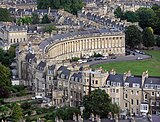
Most of Bath's Grade I listed buildings are made from the local golden-coloured Bath Stone, and date from the 18th and 19th centuries. Their dominant architectural style is Georgian, which evolved from the Palladian revival style that became popular during the early 18th century. This led to the entire city's designation as a World Heritage Site. Much of the development, and many of the buildings, were the vision of John Wood, the Elder. The Circus is seen as the pinnacle of Wood's work. The best known of Bath's terraces is the Royal Crescent, designed by Wood's son, John Wood, the Younger. Around 1770 the neoclassical architect Robert Adam designed Pulteney Bridge, a three-arched bridge spanning the Avon. Outside the city of Bath most of the Grade I listed buildings are Norman- or medieval-era churches, many of which are included in the Somerset towers, a collection of distinctive, mostly spireless, Gothic church towers. Manor houses such as Claverton Manor, which now houses the American Museum in Britain, and the 18th-century Newton Park, which has a landscape garden designed by Capability Brown. (Full article...)
Selected article 10
Portal:Somerset/Selected article/10
Mendip is a local government district covering a largely rural area of 285 square miles (738 km2) ranging from the Mendip Hills through on to the Somerset Levels.There are 90 Grade I listed buildings in Mendip. Most are Norman- or medieval-era churches, many of which are included in the Somerset towers, a collection of distinctive, mostly spireless Gothic church towers. The greatest concentrations of Grade I listed buildings are in Wells and Glastonbury. In Wells these are clustered around the 10th-century Cathedral Church of St Andrew, better known as Wells Cathedral, and the 13th-century Bishop's Palace. Glastonbury is the site of the Abbey, where construction started in the 7th century, and its associated buildings. The ruined St Michael's church, damaged in an earthquake of 1275, stands on Glastonbury Tor, where the site shows evidence of occupation from Neolithic times and the Dark Ages. The Chalice Well has been in use since Pre-Christian times. Glastonbury Abbey had a wider influence outside the town: tithe barns were built at Pilton and West Bradley to hold tithes, and a Fish House was built at Meare along with a summer residence for the Abbot (now Manor Farmhouse).
Medieval structures include Farleigh Hungerford Castle, and The George Inn at Norton St Philip. Manor houses such as the 15th-century Seymours Court Farmhouse at Beckington and The Old Manor at Croscombe. Mells Manor followed in the 16th century and in the 17th century Southill House in Cranmore was built. Ston Easton Park and Ammerdown House in Kilmersdon were both completed in the 18th century. The most recent buildings included in the list are churches: the Church of St Peter at Hornblotton, and Downside Abbey at Stratton-on-the-Fosse, a Roman Catholic Benedictine monastery and the Senior House of the English Benedictine Congregation. The current buildings were started in the 19th century and are still unfinished. (Full article...)
Selected article 11
Portal:Somerset/Selected article/11
North Somerset is a unitary authority in the ceremonial county of Somerset. As a unitary authority, North Somerset is administered independently of the non-metropolitan county of Somerset. Its administrative headquarters are located in the town hall of Weston-super-Mare. North Somerset includes areas that were once part of Somerset before the creation of Avon in 1974.There are 37 Grade I listed buildings in North Somerset, including the Clifton Suspension Bridge, which joins North Somerset to Bristol and Clevedon Pier. Of the listed buildings, manor houses include Clevedon Court, built in the 14th century, and from the 15th century, Ashton Court and Nailsea Court. Somerset has many religious structures; the largest number are from the Norman or medieval eras. Some of the churches are included in the Somerset towers, a collection of distinctive, mostly spireless Gothic church towers. (Full article...)
Selected article 12
Portal:Somerset/Selected article/12
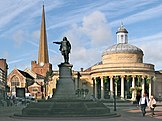
There are 53 Grade I listed buildings in Sedgemoor, 14 of which are in Castle Street, Bridgwater. In 1834, Castle Street was built on the site of the demolished Bridgwater Castle, as homes for the merchants trading in the town's port. Outside the town of Bridgwater, the largest concentration of Grade I listed buildings are in the village of Cannington, where the 12th-century Cannington Court and 14th-century Church of St Mary were both associated with a Benedictine nunnery. Cannington is also the site of the 13th-century Gurney Manor and Blackmoor Farmhouse, which was built around 1480 with its own chapel. Most of the Grade I listed buildings in Sedgemoor are Norman- or medieval-era churches, many of which are included in the Somerset towers, a collection of distinctive, mostly spireless Gothic church towers. Many of the more recent structures in the list are manor houses such as Halswell House, where the south range was built in the 16th-century for Sir Nicholas Halswell and the main north range in 1689 for Sir Halswell Tynte. The most recently constructed building in the list is the Corn Exchange in Bridgwater, built in 1834. (Full article...)
Selected article 13
Portal:Somerset/Selected article/13 South Somerset is a local government district occupying an area of 370 square miles (958 km2), stretching from its borders with Devon and Dorset to the edge of the Somerset Levels.
There are 94 Grade I listed buildings in South Somerset. Most are Norman- or medieval-era churches, many of which are included in the Somerset towers—a collection of distinctive, mostly spireless Gothic church towers—but there are other religious buildings as well. Muchelney Abbey consists of the remains and foundations of a medieval Benedictine Abbey and an early Tudor house dating from the 16th century. Stavordale Priory was built as a priory church in the 13th century. The Hamstone Stoke sub Hamdon Priory is a 14th-century former priest's house of the chantry chapel of St Nicholas.
Since the Reformation the 13th-century Hanging Chapel in Langport has been a town hall and armoury before becoming a masonic hall in 1891. The house known as The Abbey in Charlton Mackrell takes its name from the site on which it was built, the Chantry Chapel of the Holy Spirit, founded in 1237. Naish Priory in East Coker, was never a priory, and similarly the Abbey Farm House and Abbey Barn in Yeovil which date from around 1420, have always been in lay-ownership; "abbey" was added to their names in the 19th century. The Burton Pynsent Monument was designed in 1757, for William Pitt. The other Grade I listed buildings in South Somerset are manor houses, built over long periods by local Lords of the Manor such as; the Tudor Barrington Court, Newton Surmaville Lytes Cary, Tintinhull, Ven House and Brympton d'Evercy. (Full article...)
Selected article 14
Portal:Somerset/Selected article/14
Taunton Deane is a local government district with borough status covering a population of approximately 100,000.There are 38 Grade I listed buildings in Taunton Deane. The oldest buildings are churches built before the end of the 12th century, and the Castle Bow, which has been incorporated into the Castle Hotel in Taunton but was originally a gateway into Taunton Castle. The castle was created between 1107 and 1129, when William Giffard, the Chancellor of King Henry I, fortified the bishop's hall. It was his successor, Henry of Blois, who transformed the manor-house into a castle in 1138, during the Civil War that raged during the reign of his brother, King Stephen. Taunton is also the site of Gray's Alsmhouses, which dates from 1635, and two buildings in Fore Street from the 16th century. Most of the Grade I listed buildings in Taunton Deane are Norman or medieval era churches, many of which are included in the Somerset towers, a collection of distinctive, mostly spireless Gothic church towers. Many of the more recent structures in the list are manor houses such as Cothay Manor and Greenham Barton which were built in Stawley in the 15th century. Poundisford Park and Cothelstone Manor were both built in the 16th century and Hatch Court in 1755. The most recent building included in the list is Hestercombe House, which was rebuilt in 1909. (Full article...)
Selected article 15
Portal:Somerset/Selected article/15
West Somerset is a local government district covering a largely rural area, with a population, according to the 2001 census, of 35,075. The largest centres of population are the coastal towns of Minehead and Watchet. The council's administrative headquarters are in the village of Williton.There are 33 Grade I listed buildings in West Somerset. The oldest is either Culbone Church, one of the smallest churches in England, and pre-Norman in origin, or Tarr Steps, which may originate in the Bronze Age, although other sources date them from around 1400. Dunster has the greatest concentration of Grade I listed buildings, including Dunster Castle, which was built in 1617 on a site which had supported a castle for the previous 600 years; the Yarn Market, which was built in 1609; Gallox Bridge, which dates from the 15th century and the Priory Church of St George which is predominately from the 15th century but includes part of the earlier church on the same site. Other sites include manor houses such as the medieval buildings at Nettlecombe Court and Orchard Wyndham. Somerset has many religious structures, most of which are from the Norman or medieval eras. Some of the churches are part of the Somerset towers, a collection mostly spireless Gothic church towers. (Full article...)
Selected article 16
Portal:Somerset/Selected article/16 The ceremonial county of Somerset, is divided into 417 areas known as civil parishes, which form the lowest unit of local government in England. Parishes arose from Church of England divisions, and were given their current powers and responsibilities by the Local Government Act 1894. Somerset consists of a non-metropolitan county administered by Somerset County Council, divided into five districts and two unitary authorities. The districts of Somerset are West Somerset, South Somerset, Taunton Deane, Mendip and Sedgemoor. The two administratively independent unitary authorities, are North Somerset and Bath and North East Somerset.
The city of Bath is the largest centre of population in Bath and North East Somerset. Areas of the city that were formerly within the Bath County Borough are now unparished, but the rest of the authority is divided into 49 parishes. All of North Somerset, is covered by its 39 parishes. South Somerset is the largest of Somerset's five districts. It has a population of about 158,000, living in 121 parishes. Part of Taunton formerly within Taunton Municipal Borough is unparished, but the rest of Taunton Deane is divided into 49 parishes. West Somerset is a largely rural area, with a population of 35,075 in an area of 740 square kilometres (290 sq mi). Sedgemoor has 54 parishes. The Mendip district covers a largely rural area of 738 square kilometres (285 sq mi), ranging from the Mendip Hills through on to the Somerset Levels. It has a population of about 110,000, living in 62 parishes. (Full article...)
Selected article 17
Portal:Somerset/Selected article/17
The Kennet and Avon Canal is a canal in southern England. There are a total of 105 locks on the Kennet and Avon Canal from Bristol to the River Thames, including 6 on the navigable section of the River Avon from Bristol to Bath and 9 on the navigable section of the River Kennet to its confluence with the Thames near Reading. The remaining 90 locks lie along the 57 miles (92 km) of canal.In Bath the canal separates from the river but follows its valley as far as Bradford on Avon. The ornate Bath Locks lead to a stretch through Limpley Stoke valley with few locks. The flight of locks at Devizes, including the Caen Hill Locks, raises the canal to its longest pound, which then ascends the 4 Wooton Rivers locks to the short summit pound which includes the Bruce Tunnel. Pumping stations are used to supply the canal with water. The canal continues through the rural landscape of Wiltshire and Berkshire before joining the River Kennet at Newbury and becoming a navigable river to Reading, where it flows into the River Thames.
In the later 19th century and early 20th century the canal fell into disuse following competition from the Great Western Railway, who owned the canal. Between 1970 and 1990 the canal was restored, largely by volunteers, and today is a popular heritage tourism destination, for boating, canoeing, fishing, walking and cycling. (Full article...)
Selected article 18
Portal:Somerset/Selected article/18

Natural England took over the role of designating and managing SSSIs from English Nature in October 2006 when it was formed from the amalgamation of English Nature, parts of the Countryside Agency and the Rural Development Service. Natural England, like its predecessor, uses the 1974-1996 county system,and as such the same approach is followed here, therefore some sites you may expect to find in this list could be in the Avon list. (Full article...)
Selected article 19
Portal:Somerset/Selected article/19
Somerset County Cricket Club are an English cricket club based in Taunton, Somerset. The club was founded in 1875 after a match between "Gentlemen of Somerset" and "Gentlemen of Devon" in Sidmouth, Devon. Somerset played their first undisputed first-class cricket match in 1882 against Lancashire. After missing the first season of the official County Championship, Somerset was admitted for the second in 1891, and have participated in the competition ever since. Brian Langford holds the record for the greatest number of first-class appearances for Somerset having played 504 times for the club. Only three other players have made more than 400 appearances for Somerset, and no-one has reached the milestone since Langford. Jack White, one of the three, is the club's leading wicket-taker in first-class cricket. Harold Gimblett's tally of 21,142 first-class runs is the most by a Somerset cricketer.Despite Peter Denning and Graham Rose, both Englishmen, jointly holding the record for most List A appearances for Somerset, it is West Indians that top both the batting and bowling charts. Viv Richards, named by Wisden as the greatest One Day International batsman of all time, holds the record for the most runs in one-day cricket for Somerset. Barbadian Hallam Moseley ranks as the top wicket-taker, claiming 309 wickets in one-day cricket, nine more than England Test cricketer Ian Botham. (Full article...)
Selected article 20
Portal:Somerset/Selected article/20

Many of the museums are in listed buildings. In the United Kingdom, this signifies a building which has been placed on the Statutory List of Buildings of Special Architectural or Historic Interest. In England and Wales, the authority for listing is granted by the Planning (Listed Buildings and Conservation Areas) Act 1990, and is presently administered by English Heritage. Listed buildings in danger of decay are included on English Heritage's Buildings at Risk Register. There are three types of listed status: Grade I, for buildings "of exceptional interest, sometimes considered to be internationally important"; Grade II*, for "particularly important buildings of more than special interest"; and Grade II, for buildings that are "nationally important and of special interest".
Many of the museums have been accredited by the Museums, Libraries and Archives Council, which sets national standards for museums in the UK. Several are art galleries providing space for the exhibition of art, or are philatelic, regimental, science, aviation, transport, railway, toy, religious or sports museums, but the majority are local museums. There are also several historic house museums owned or managed by the National Trust or English Heritage. (Full article...)
Selected article 21
Portal:Somerset/Selected article/21
The Ashton Court Festival was an outdoor music festival held annually in mid-July on the grounds of Ashton Court, just outside Bristol. The festival was a weekend event which featured a variety of local bands and national headliners. Mainly aimed at local residents, the festival did not have overnight camping facilities and was financed by donations and benefit gigs.Starting as a small one day festival in 1974, the festival grew during succeeding years and was said to be Britain's largest free festival until changes brought on by government legislation resulted in compulsory fees and security fencing being introduced. After problems were caused by a temporary move to Hengrove Park in 2001, due to the foot and mouth crisis, and a washout in 2007, the organisers declared bankruptcy in 2007. (Full article...)
Selected article 22
Portal:Somerset/Selected article/22
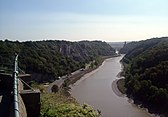
On the east of the gorge is the Bristol suburb of Clifton, and The Downs, a large public park. To the west of the gorge is Leigh Woods, the name of both a village and the National Trust forest it is situated in. There are three Iron Age hill forts overlooking the gorge, as well as an observatory. The Clifton Suspension Bridge, an icon of Bristol, crosses the gorge. (Full article...)
Selected article 23
Portal:Somerset/Selected article/23
The Blackdown Hills are a range of hills along the Somerset-Devon border in south-western England, which were designated an Area of Outstanding Natural Beauty (AONB) in 1991. The plateau is dominated by hard chert bands of Upper Greensand with some remnants of chalk, and is cut through by river valleys. The hills support an extensive range of wildlife leading to the designation of 16 Sites of Special Scientific Interest (SSSIs).There is evidence of human occupation since the Iron Age. Fortifications include the remains of ancient hill forts, Norman motte-and-bailey castles and Second World War airfields. There are also religious buildings such as Dunkeswell Abbey and village churches. The hills are crossed by a network of minor roads with major transport routes including the M5 motorway running around the periphery. (Full article...)
Selected article 24
Portal:Somerset/Selected article/24
The Bridgwater and Taunton Canal is a canal between Bridgwater and Taunton, opened in 1827 and linking the River Tone to the River Parrett. There were a number of abortive schemes to link the Bristol Channel to the English Channel by waterway in the 18th and early 19th centuries. These schemes followed the approximate route eventually taken by the Bridgwater and Taunton Canal, but the canal was instead built as part of a plan to link Bristol to Taunton by waterway.The early years of operation were marred by a series of legal disputes, which were resolved when the Bridgwater and Taunton Canal Company and the Conservators, who managed the River Tone Navigation, agreed that the Canal Company should take over the Tone Navigation. The canal originally terminated at a basin at Huntworth, to the east of Bridgwater, but was later extended to a floating harbour on its western edge. Financially this was a disaster, as the extension was funded by a mortgage, and the arrival of the railways soon afterwards started the demise of the canal. The canal was rescued from bankruptcy by the Bristol and Exeter Railway in 1866.
Despite commercial traffic ceasing in 1907, the infrastructure was maintained in good order, and the canal was used for the transport of potable water from 1962. The Countryside Act 1968 provided a framework for Somerset County Council to start the restoration of the canal as a leisure facility, which was completed in 1994, when the canal was reopened throughout. Bridgwater Docks have been restored as a marina, but there is no navigable connection to the River Parrett, as the canal still transports drinking water for the people of Bridgwater. (Full article...)
Selected article 25
Portal:Somerset/Selected article/25
The buildings and architecture of Bath, reveal significant examples of the architecture of England, from the Roman Baths (including their significant Celtic presence), to the present day. The city became a World Heritage Site in 1987, largely because of its architectural history and the way in which the city landscape draws together public and private buildings and spaces. The many examples of Palladian architecture are purposefully integrated with the urban spaces to provide "picturesque aestheticism". It is the only entire city in Britain to achieve World Heritage status, and is a popular tourist destination.Important buildings include the Roman Baths; neoclassical architect Robert Adam's Pulteney Bridge, based on an unused design for the Rialto Bridge in Venice; and Bath Abbey in the city centre, founded in 1499 on the site of an 8th century church. Of equal importance are the residential buildings designed and built into boulevards and crescents by the Georgian architects John Wood, the Elder and his son John Wood, the Younger - well-known examples being the Royal Crescent, and The Circus.
Most of Bath's buildings are made from the local, golden-coloured, Bath Stone. The dominant architectural style is Georgian, which evolved from the Palladian revival style that became popular in the early 18th century. According to UNESCO the architecture of the city provides... "an integration of architecture, urban design, and landscape setting, and the deliberate creation of a beautiful city". Development during modern eras, including the development of the transport infrastructure and rebuilding after bomb damage during World War II, has mostly been in keeping with earlier styles to maintain the integrated cityscape. (Full article...)
Selected article 26
Portal:Somerset/Selected article/26
Cheddar Gorge is a limestone gorge in the Mendip Hills, near the village of Cheddar. The gorge is the site of the Cheddar show caves, where Britain's oldest complete human skeleton, Cheddar Man, estimated to be 9,000 years old, was found in 1903. Older remains from the Upper Late Palaeolithic era (12,000–13,000 years ago) have been found. The caves, produced by the activity of an underground river, contain stalactites and stalagmites.Cheddar Gorge, including the caves and other attractions, has become a tourist destination. In a 2005 poll of Radio Times readers, following its appearance on the 2005 television programme Seven Natural Wonders, Cheddar Gorge was named as the second greatest natural wonder in Britain, surpassed only by Dan yr Ogof caves. The gorge attracts about 500,000 visitors per year. (Full article...)
Selected article 27
Portal:Somerset/Selected article/27

The low lying areas of the North Somerset Levels and Somerset Levels have been subject to thousands of years of flooding and man's attempts to control the flow of water. In the north of the county the Limestone of the Mendip Hills dominates the landscape, while in the south the Blackdown and Quantock Hills rise out of the levels. The highest areas are on Exmoor. The wide variety of landscapes has led to several areas being designated as Sites of Special Scientific Interest for geological reasons, and support a range of flora and fauna as can be seen from the List of Sites of Special Scientific Interest in Somerset (Full article...)
Selected article 28
Portal:Somerset/Selected article/28
The Glastonbury Festival of Contemporary Performing Arts, commonly abbreviated to Glastonbury or Glasto, is the largest green field open-air music and performing arts festival in the world. The festival is best known for its contemporary music, but also features dance, comedy, theatre, circus, cabaret and many other arts. For 2005, the enclosed area of the festival was over 900 acres (3.6 km²), had over 385 live performances and was attended by around 150,000 people. In 2007, over 700 acts played on over 80 stages and the capacity expanded by 20,000 to 177,000. (Full article...)Selected article 29
Portal:Somerset/Selected article/29
The Grand Western Canal ran between Taunton in Somerset and Tiverton in Devon. The canal had its origins in various plans, going back to 1796, to link the Bristol Channel and the English Channel by a canal, bypassing Lands End. An additional purpose of the canal was the supply of limestone and coal to lime kilns along with the removal of the resulting quicklime, which was used as a fertiliser and for building houses. This intended canal-link was never completed as planned, as the coming of the railways removed the need for its existence.Construction was in two phases. A level section from Tiverton to Lowdwells on the Devon/Somerset border, opened in 1814, and was capable of carrying broad-beam barges, carrying up to 40 tons. The Somerset section, suitable for tub-boats, which were about 20 feet (6.1 m) long and capable of carrying eight tons, opened in 1839. It included an inclined plane and seven boat lifts, the earliest lifts to see commercial service in the UK. The lifts predated the Anderton Boat Lift by nearly 40 years.
The Devon section remains open, despite various threats to its future, and is now a designated country park, and allows some limited navigation. The Somerset section was closed in 1867, and is gradually disappearing from the landscape, although sections are now used as a footpath. It maintains a historical interest and has been subject to some archaeological excavations. (Full article...)
Selected article 30
Portal:Somerset/Selected article/30
The history of evidence of human occupation in Somerset began in prehistoric times with hand axes and flint points from the Palaeolithic era being uncovered, and a range of burial mounds, hill forts and other artifacts dating from the Mesolithic era. The oldest dated human road work in Great Britain is the Sweet Track, constructed across the Somerset Levels with wooden planks in the 39th century BC.Following the Roman invasion of Great Britain the mining of lead and silver in the Mendip Hills provided a basis for local industry and commerce. Bath became the site of a major Roman fort and city, the remains of which can still be seen. During the Dark Ages and Saxon period Somerset was the scene of battles first with the Britons and later with the Danes and was ruled by various kings of Wessex, succeeded by kings of England. Following the defeat of the Anglo-Saxons by the Normans in 1066, castles were built in Somerset.
Expansion of the population and settlements in the county continued during the Tudor and more recent periods. Agriculture and coal mining expanded until the 18th century, although other industries declined during the industrial revolution. In modern times the population has grown, particularly in the seaside towns, notably Weston-super-Mare. Agriculture continues to be a major business, if no longer a major employer because of mechanisation. Light industries take place in towns such as Bridgwater and Yeovil. The towns of Taunton and Shepton Mallet manufacture cider, although the acreage of apple orchards is less than it once was. (Full article...)
Selected article 31
Portal:Somerset/Selected article/31

The River Kennet was made navigable to Newbury in 1723, and the River Avon to Bath in 1727. The canal between Newbury and Bath opened in 1810 and is 57 miles (92 km) long. The two river navigations and the canal total 87 miles (140 km) in length. In the later 19th century and early 20th century the canal fell into disuse following competition from the Great Western Railway, who owned the canal. In the latter half of the 20th century the canal was restored, largely by volunteers, and today is a popular heritage tourism destination, for boating, canoeing, fishing, walking and cycling. It is also important for wildlife conservation.
The section from Bristol to Bath is the course of the River Avon, which flows through a wide valley and has been made navigable by a series of locks and weirs. In Bath the canal separates from the river but follows its valley as far as Bradford on Avon. The ornate Bath Locks lead to a stretch through Limpley Stoke valley with few locks. The flight of locks at Devizes raises the canal to its longest pound, which then ascends the 4 Wooton Rivers locks to the short summit pound which includes the Bruce Tunnel. Pumping stations are used to supply the canal with water. The canal continues through the rural landscape of Wiltshire and Berkshire before joining the River Kennet at Newbury and becoming a navigable river to Reading, where it flows into the River Thames. (Full article...)
Selected article 32
Portal:Somerset/Selected article/32
The Roman Baths complex is a site of historical interest in the English city of Bath. The house is a well-preserved Roman site for public bathing. The Roman Baths themselves are below the modern street level. There are four main features: the Sacred Spring, the Roman Temple, the Roman Bath House and the Museum holding finds from Roman Bath. The buildings above street level date from the 19th century.The Baths are a major tourist attraction and, together with the Grand Pump Room, receive more than one million visitors a year, with 1,037,518 people during 2009. It was featured on the 2005 TV program Seven Natural Wonders as one of the wonders of the West Country. Visitors can see the Baths and Museum but cannot enter the water. An audio guide is available in several languages.
In 2009 a grant of £90,000 was made to Bath and North East Somerset Council to contribute towards the cost of re-developing displays and improving access to the Roman Baths, by the Department for Culture, Media and Sport/Wolfson Fund, which was established to promote improvements in Museums and Galleries in England. (Full article...)
Selected article 33
Portal:Somerset/Selected article/33

A feature of the canal was the variety of methods used at Combe Hay to overcome height differences between the upper and lower reaches of the canal, initially by the use of caisson locks and when this failed an inclined plane and then a flight of 22 locks.
The Radstock arm was never commercially successful and was replaced first with a tramway in 1815 and later incorporated into the Somerset and Dorset Joint Railway. The Paulton route flourished for some years until the coming of the railway and closed in 1898. Much of the course of the canal has since been used for a railway. In October 2006 a grant was obtained from the Heritage Lottery Fund to carry out a technical study on one of the locks and associated structures at Combe Hay. (Full article...)
Selected article 34
Portal:Somerset/Selected article/34

The Somerset Levels consist of marine clay "levels" along the coast, and the inland (often peat based) "moors". The area borders the Severn Estuary with its very high tidal range which used to cause marine flooding, but this is now largely controlled by various sea defences. The Levels are divided into two by the Polden Hills, with the catchment areas of the River Parrett to the south, and the rivers Axe and Brue to the north. This area is separate from the North Somerset Levels, which is located inland from Weston-super-Mare.
The total area of the Levels amounts to approximately 160,000 acres (650 km2). It broadly corresponds to the administrative district of Sedgemoor but also includes the south east of Mendip district. Approximately 70% of the area is grassland and 30% is arable.
Discussions have taken place concerning the possibility of obtaining World Heritage Site status for the Somerset Levels and Moors as a "cultural landscape". It was suggested that if this bid were successful, it could improve flood control, but only if wetland fens were created again. These plans were discontinued in June 2010. (Full article...)
Selected article 35
Portal:Somerset/Selected article/35
Worlebury Camp is the name of the place where an Iron Age hill fort once stood atop Worlebury Hill, which is north of the town of Weston-super-Mare. This fort was designed for defense, as is evidenced the number of walls and ditches around the site. Archaeologists have found several large triangular platforms around the sides of the fort, lower down on the hillside. They have found nearly one hundred storage pits of various sizes cut into the bedrock, and many of these had human remains, coins, and other artifacts in them. However, in more recent times, the fort has suffered damage and been threatened with complete destruction on multiple occasions. This location has been designated a Scheduled Ancient Monument, and it falls within the Weston Woods Local Nature Reserve which was declared to Natural England by North Somerset Council in 2005. (Full article...)Selected article 36
Portal:Somerset/Selected article/36
A cricket tournament, played as part of the 1900 Summer Olympics, took place on 19–20 August at the Vélodrome de Vincennes. The only match of the tournament was played between teams representing Great Britain and France, and was won by 158 runs by Great Britain.Originally, teams representing Belgium, France, Great Britain, and the Netherlands were scheduled to compete in the tournament. Belgium and the Netherlands pulled out of the competition, leaving Great Britain to play France. Neither team was nationally selected. The British side was a touring club, the Devon and Somerset Wanderers, while the French team, the French Athletic Club Union, consisted mainly of British expatriates living in Paris. (Full article...)
Selected article 37
Portal:Somerset/Selected article/37
Nunney Castle is a castle in Nunney, Somerset, England. Built in the late 14th century by Sir John Delamare on the profits of his involvement in the Hundred Years War, the moated castle's architectural style, possibly influenced by the design of French castles, has provoked considerable academic debate. Remodelled during the late 16th century, Nunney Castle was damaged during the English Civil War and is now ruined. English Heritage maintain the site as a tourist attraction. The architectural historian Nikolaus Pevsner has described Nunney as "aesthetically the most impressive castle in Somerset." (Full article...)Selected article 38
Portal:Somerset/Selected article/38
Farleigh Hungerford Castle, is a medieval castle in Farleigh Hungerford. The castle was built in two phases: the inner court was constructed between 1377 and 1383 by Sir Thomas Hungerford, who made his fortune working as a steward to John of Gaunt. The castle was built to a quadrangular design, already slightly old-fashioned, on the site of an existing manor house overlooking the River Frome. A park was attached to the castle, requiring the destruction of a local village.The castle largely remained in the hands of the Hungerford family over the next two centuries, despite periods during the War of the Roses in which it was held by the Crown following the attainder and execution of members of the family. At the outbreak of the English Civil War in 1642, the castle, modernized to the latest Tudor and Stuart fashions, was held by Sir Edward Hungerford. Edward declared his support for Parliament, becoming a leader of the Roundheads in Wiltshire. Farleigh Hungerford was seized by Royalist forces in 1643, but recaptured by Parliament without a fight near the end of the conflict in 1645. As a result it escaped slighting following the war, unlike many other castles in the south-west of England. In the 1915 Farleigh Hungerford Castle was sold to the Office of Works and a controversial restoration programme began. It now owned by English Heritage, who operate it as a tourist attraction, and the castle is a Grade I listed building and a Scheduled Ancient Monument. (Full article...)
Selected article 39
Portal:Somerset/Selected article/39
Glastonbury Abbey was a monastery in Glastonbury, Somerset, England. The ruins are now a grade I listed building, and a Scheduled Ancient Monument and are open as a visitor attraction. The origins are unclear although Glastonbury was a religious site in pre-Christian times. The abbey was founded in the 7th century and enlarged in the 10th, before a major fire in 1184 destroyed the buildings. It was rebuilt and by the 14th century was one of the richest and most powerful monasteries in England. The abbey also controlled large tracts of surrounding land and was instrumental in major drainage projects on the Somerset Levels. The abbey was suppressed during the Dissolution of the Monasteries under King Henry VIII of England and the last Abbot Richard Whiting (Whyting) was hanged, drawn and quartered as a traitor on Glastonbury Tor in 1539. From at least the 12th century the Glastonbury area was frequently associated with the legend of King Arthur, a connection promoted by medieval monks who asserted that Glastonbury was Avalon. Christian legends have also claimed that the abbey was founded by Joseph of Arimathea in the 1st century. (Full article...)Selected article 40
Portal:Somerset/Selected article/40
The Abbey Church of Saint Peter and Saint Paul, Bath, commonly known as Bath Abbey, is an Anglican parish church and a former Benedictine monastery in Bath, Somerset, England. Founded in the 7th century, Bath Abbey was reorganised in the 10th century and rebuilt in the 12th and 16th centuries; major restoration work was carried out by Sir George Gilbert Scott in the 1860s. It is one of the largest examples of Perpendicular Gothic architecture in the West Country.The church is cruciform in plan, and is able to seat 1200. An active place of worship, with hundreds of congregation members and hundreds of thousands of visitors each year, it is used for religious services, secular civic ceremonies, concerts and lectures. The choir performs in the abbey and elsewhere. There is a heritage museum in the vaults. The abbey is a Grade I listed building, particularly noted for its fan vaulting ceiling. It contains war memorials for the local population and monuments to several notable people, in the form of wall and floor plaques and commemorative stained glass. The church has two organs and a peal of ten bells. The west front includes sculptures of angels climbing to heaven on two stone ladders. (Full article...)
Selected article 41
Portal:Somerset/Selected article/41 In the 2009 season, Somerset County Cricket Club competed in four domestic competitions: the first division of the County Championship, the Friends Provident Trophy, the first division of the NatWest Pro40 League and the Twenty20 Cup. Their performance in the Twenty20 Cup saw them qualify for the Champions League Twenty20. They enjoyed a successful season, but fell short of winning in any of the competitions, prompting Director of Cricket Brian Rose to say "We've had enough of being cricket's nearly men."
Consistent performances in the County Championship helped Somerset remain challengers for the competition until the last few weeks of the season, but the batting-friendly pitch at Taunton saw the county finish with too many draws to claim their first Championship title. Consistency was also key for Somerset's success in one-day cricket, where they remained unbeaten in the group stage of the Friends Provident Trophy, but were eliminated in the first knock-out round, and finished runners-up by one point in the NatWest Pro40. In the Twenty20 Cup, Somerset qualified for the quarter-finals as one of the best third-placed teams, and eventually finished as losing finalists. This meant that they qualified for the Champions League Twenty20, where they progressed into the second group stage of the competition. They failed to win any matches in that phase of the competition, resulting in their elimination.
They were captained for the third successive season by their Australian overseas player, Justin Langer, who announced during the season that it would be his last with Somerset. Marcus Trescothick topped the batting tables, accruing almost 3,000 runs in all competitions in 2009, which saw him named as both Professional Cricketers' Association (PCA) Player of the Year and the PCA's Most Valuable Player of the Year. (Full article...)
Selected article 42
Portal:Somerset/Selected article/42 The 1885 season was an annus horribilis for Somerset County Cricket Club. Captained by Edward Sainsbury, who had taken over from Stephen Newton, captain for the previous three seasons, they played six first-class cricket matches. Somerset's only win of the season came in their first match; all the other were lost. Two of the losses, those away against Gloucestershire and Surrey, number among the county's ten heaviest defeats. Somerset were unable to field a full team for their fourth match, which coupled with their poor results and lack of fixtures resulted in the club being stripped of its first-class status at the end of the season.
At an emergency meeting held in Taunton a new club secretary was appointed and wealthy benefactors were sought, but Sainsbury retained the club captaincy. Somerset played second-class cricket for five seasons, until their readmission to the first-class game for the 1891 season.
In their histories of Somerset County Cricket Club, Peter Roebuck and David Foot mostly gloss over the season; Roebuck includes a scorecard, but provides only two paragraphs of prose, while Foot only mentions the loss of first-class cricket. (Full article...)
Selected article 43
Portal:Somerset/Selected article/43
In the 1960s and '70s restoration was carried out by students from the University of Bath and the Kennet and Avon Canal Trust, who replaced and repaired the buildings and equipment and returned the pumping station to a functional state by 1978. It is now operated by volunteers from the Trust, open to the public as an industrial heritage museum. (Full article...)
Selected article 44
Portal:Somerset/Selected article/44
Dunster Castle is a former motte and bailey castle, now a country house, in the village of Dunster. The castle lies on the top of a steep hill called the Tor, and has been fortified since the late Anglo-Saxon period. After the Norman conquest of England in the 11th century, William de Mohun constructed a timber castle on the site as part of the pacification of Somerset. A stone shell keep was built on the motte by the start of the 12th century, and the castle survived a siege during the early years of the Anarchy. At the end of the 14th century the de Mohuns sold the castle to the Luttrell family, who continued to occupy the property until the late 20th century.The castle was expanded several times by the Luttrell family during the 17th and 18th centuries; they built a large manor house within the Lower Ward of the castle in 1617, and this was extensively modernised, first during the 1680s and then during the 1760s. The medieval castle walls were mostly destroyed following the siege of Dunster Castle at the end of the English Civil War, when Parliament ordered the defences to be slighted to prevent their further use. In the 1860s and 1870s, the architect Anthony Salvin was employed to remodel the castle to fit Victorian tastes; this work extensively changed the appearance of Dunster to make it appear more Gothic and Picturesque.
Following the death of Alexander Luttrell in 1944, the family was unable to afford the death duties on his estate. The castle and surrounding lands were sold off to a property firm, the family continuing to live in the castle as tenants. The Luttrells bought back the castle in 1954, but in 1976 Colonel Walter Luttrell gave Dunster Castle and most of its contents to the National Trust. As of 2011 the castle is operated by the trust as a tourist attraction; it is a Grade I listed building and scheduled monument. (Full article...)




